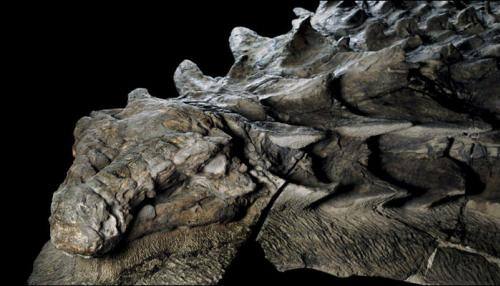- News>
- Science
Supremely well-preserved new dinosaur fossil found in Alberta gives the impression of a statue!

The remnants of skin which are fossilized, cover the armor plates on the dinosaur`s remains, which are petrified from the head to the hips.
New Delhi: On Friday, May 13 – six years after miners had discovered it by accident, the best preserved dinosaur fossil was was unveiled at Canada’s Royal Tyrrell Museum of Paleontology.
Dinosaur fossils are not more than a rock for the casual observers, before they are put into the museum.
However, the observers this time were in for a surprise. The remains of the dinosaur were so well-preserved that it looked more like a statue than a fossil, as per a report by the National Geographic.
The remnants of skin which are fossilized, cover the armor plates on the dinosaur’s remains, which are petrified from the head to the hips. “We don’t just have a skeleton. We have a dinosaur as it would have been,” Caleb Brown said, National Geographic reported.
The accidental discovery of the fossil has an interesting story. As per Science Alert, on March 21, 2011, Shawn Funk was digging in Alberta's Millennium Mine with a mechanical backhoe, when he hit "something much harder than the surrounding rock."
A closer look revealed something that looked like no rock Funk had ever seen, just "row after row of sandy brown disks, each ringed in gunmetal gray stone".
What he had found was a 2,500-pound (1,130 kg) dinosaur fossil, which was soon shipped to the museum in Alberta, where technicians scraped extraneous rock from the fossilised bone and experts examined the specimen.
"I couldn't believe my eyes – it was a dinosaur," Donald Henderson, the curator of dinosaurs at the museum, told Alberta Oil.
"When we first saw the pictures we were convinced we were going to see another plesiosaur (a more commonly discovered marine reptile)."
More specifically, it was the snout-to-hips portion of a nodosaur, a "member of the heavily-armored ankylosaur subgroup," that roamed during the Cretaceous Period, according to Smithsonian.
Usually, only the bones and teeth are preserved. Some other dinosaur fossils have been found in flat “mummified” form. These fossils maintain a shape that is so near to life that it “might have been walking around a couple of weeks ago,” Jakob Vinther, a paleobiologist, told National Geographic.
According to The TeCake, around 110-million-year-old fossil revealed a new species of nodosaur having thorny armor which is used to protect them against the predators. It also had two, 20-inch-long spikes which protruded from its shoulders.
They were a group of heavy herbivores, which used to walk on four legs, and somewhat resembled a cross between a lizard and a lion having the only difference of being covered in scales. “These guys were like four-footed tanks,” dinosaur tracker Ray Stanford said in The Washington Post in the year 2012.
This particular species of them was 18 feet (5.4 meters) long and weighed around 3,000 pounds (1,360 kilograms).
“The more I look at it, the more mind-boggling it becomes. Fossilized remnants of skin still cover the bumpy armor plates dotting the animal’s skull. Its right forefoot lies by its side, its five digits splayed upward. I can count the scales on its sole.”
Caleb Brown, a postdoctoral researcher at the museum, says “We don’t just have a skeleton”. “We have a dinosaur as it would have been.”
Eventually, this creature of land floated out to the sea to where it was once found and sank to the bottom. According to the researchers, it was on a river’s edge, probably drinking water, when a flood swept it away.
The minerals present there quickly “infiltrated the skin and armor and cradled its back, ensuring that the dead nodosaur would keep its true-to-life form as eons’ worth of rock piled atop it.”
However, if one needs to reach out to the bones of the dinosaur’s it would require destroying its outer layers.
CT scans done by the National Geographic Society has revealed a little, as the rocks are very opaque.
“Even partially complete skeletons remain elusive,” Smithsonian said in a report.
